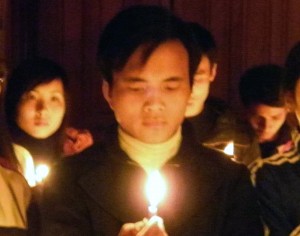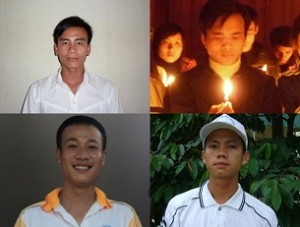Last line of Defence - Tuyến Phòng Thủ Cuối Cùng
Featured
-
Open letter to Diplomatic Missions of the democratic countries in Vietnam
-
Thư ngỏ của gia đình TNLT Trịnh Bá Phương gửi phái bộ ngoại giao các nước dân chủ
-
Imprisoned activist Trinh Ba Phuong charged for writing ‘down with communism’
-
TNLT Trịnh Bá Phương bị khởi tố khi đang thi hành án tù mười năm
-
Một thương binh bị bắt vì giúp người dân khiếu kiện
-
Thành viên thứ hai của Tập hợp Dân chủ Đa nguyên bị bắt tạm giam
-
Tù nhân chính trị ở Trại giam Xuân Lộc kêu cứu vì bị bỏ đói
Recent Comments
-
Height Insoles: Hi, I do believe this is an excellent site. I stumbledupon …
-
http://fishinglovers.net: Appreciate you sharing, great post.Thanks Again. Keep writi…
-
Achilles Pain causes: Every weekend i used to pay a quick visit this site, as i w…
Powered by WordPress • Themify WordPress Themes






October 15, 2018
Say a prayer for Vietnam’s forgotten Montagnards
by Nhan Quyen • [Human Rights]
Communist regime’s repression of the ethnic minority that supported the US during the Vietnam War has been largely invisible but is starting to come to light
By Dan Southerland, Washington Post, October 13, 2018
Let’s start with a confession. When I was a war reporter in Vietnam in the late 1960s and early 1970s, I disapproved of “parachute journalism.”
This was the practice of flying into a combat zone by helicopter and staying a day or two to get a feel for the situation and then rush back to Saigon to file a story.
But when it came to one part of Vietnam—the strategically significant Central Highlands bordering Cambodia and Laos and located north of the Mekong Delta—I was in and out fairly quickly.
I can remember flying into the highlands city of Kontum with a colleague when that city was subject to North Vietnamese artillery and rocket fire in the spring of 1972. The two of us took a quick look, talked to an American advisor and a few South Vietnamese soldiers, and got out.
The fact that we saw little of the region’s ethnic minority people, including the main Montagnard minority, in Kontum eluded me, although they had once lived as the majority population there. Looking back on it, shouldn’t I have at least started asking, “Hey, where are the Montagnards?”
More than 40 years later, one might ask the same question.
The Montagnards, who were some of the American Army’s most loyal allies during the Vietnam War, are now hidden from view and simply trying to survive under a repressive state. Their lives are dominated by ethnic Vietnamese who have taken over much of their ancestral lands.
At the same time, Montagnards who escaped to the United States are increasingly stepping forward to tell the story of their lost lands and the challenges faced by those they left behind.
In the mid-1950s, the 1960s, and early 1970s, North Vietnamese refugees, poor South Vietnamese from coastal regions, and minorities other than Montagnards had moved into the highlands to seek land and work.
In many cases they seized the ancestral lands of the Montagnards while offering them no compensation. These outsiders thereby quickly came to dominate the region.
During their colonial rule in Vietnam, the French used the term Montagnards, or “people of the mountains,” to describe the various tribes living in the highlands of southern Vietnam.
Michael Benge is an American expert on the Montagnards who worked for six years with them during the Vietnam War. Benge, who worked first for the International Voluntary Services (IVS) and then for the US Agency for International Development (USAID), notes that hill tribes of Vietnam are not monolithic.
The various hill-tribes had no collective name other than the name Montagnards imposed on them by the French and later adopted by the Americans, said Benge. They are mainly of Malayo-Polynesian, Mon-Khmer, and Sino-Tibetan extraction, he says.
If the Montgnards were to choose a name for themselves, their preference would probably be Anak Cu Chiang, or “Children of the Mountains,” according to Benge.
Under the French, the Montagnards enjoyed considerable autonomy, said Benge, who arrived in Vietnam in 1963. The French appointed Montagnards to official positions from the provincial level down to the hamlet level. But the Montagnards couldn’t obtain higher positions in the French system.
After assuming power, the South Vietnamese tended to look down on the Montagnards as primitive, calling them Moi, or savages. As such tensions between the Vietnamese and Montagnards grew over the years.
In 1964, several Montagnard military units launched an abortive revolt against the South Vietnamese government led by Premier Ngo Dinh Diem. The Saigon-based government had forced Montagnards to take Vietnamese names, abolished their court system, and banned customs and traditions that had been respected by the French.
But things got even worse for the Montagnards after the South Vietnamese government fell and the Communists came to power in the spring of 1975.
The Montagnards’ plight, however, has drawn little media attention in recent years. A recent symposium on Vietnam held at the National Archives building in Washington, DC, has turned a spotlight on the country’s oppressed minority.
Speaking on a panel at the September 14 event titled “Vietnam Revisited,” Neil Nay, an ethnic Montagnard and spokesman for the group, described their years of suffering under Communist rule. In his presentation, Nay said that in the Central Highlands today authorities are systematically abolishing traditional ways of life.
As he explained it, internal security officers and the secret police “are constantly monitoring us like prisoners.” Most Montagnards cannot afford to send their children to school. The Vietnamese government considers the Montagnards as “an historical enemy,” Nay said. Churches are monitored and often charged with being anti-state organizations.
The Montagnards have long been stuck in the middle of tough situations. During the fighting that occurred in Vietnam during a 30-year-period from 1945 until 1975, the Montagnards were recruited by all sides and suffered heavy casualties.
After President John Kennedy sent US Special Forces to South Vietnam as advisors in May of 1961, the Montagnards formed militia forces to act as rapid reaction forces against the North Vietnamese. They also helped to disrupt the infiltration of North Vietnamese troops and supplies into South Vietnam.
The Special Forces, known as Green Berets, provided training and weapons to the Montagnards, and many of the American soldiers developed close bonds with the tribesmen.
According to Nay, the Montagnards lost more than 250,000 men in the many battles that engulfed them. These battles raged across the highlands, and by the end of the war, many Montagnards felt abandoned by all sides.
Some of them escaped as refugees into nearby Cambodia and Thailand and made it from there to the US. A number of them, however, are still languishing under arrest in Thailand.
Once the Communists defeated the South Vietnamese and took power in South Vietnam in the spring of 1975, life became much worse for the already beleaguered Montagnards. Some of the leaders who survived were executed. Others died in so-called re-education camps or in prisons.
The Montagnards lost whatever limited rights that they had previously enjoyed. The Communists had recruited a number of Montagnards to fight on their side, promising them autonomy once they gained power. That never came to pass.
When the thousands of Montagnards protested religious repression and the confiscation of their ancestral lands in 2001 and 2004, the army and police cracked down hard.
At the same time, the Montagnards gained new strength through religion. Starting in 1975, many of them abandoned their animistic beliefs and converted to Christianity.
Responding to international concerns about continuing crackdowns, the Vietnamese government took a few steps to address Montagnard grievances.
In July 2004, then Prime Minister Pham Van Khai issued a decree under which low-income Montagnard families were to receive farm land or at least 200 square meters of housing land.
The government also announced it would temporarily suspend the migration of lowland Vietnamese to the Central Highlands.
According to Human Rights Watch (HRW), the government also passed new regulations aimed to allow the Montagnards more religious freedom, including the banning of forced recantations of faith.
But HRW research conducted from 2005 to 2006 showed that Vietnamese officials continued to violate religious freedom rights in parts of the Central Highlands. For example, large Christian gatherings continued to be banned unless presided over by officially recognized pastors.
According to a number of refugee accounts, in the face of imprisonment and torture, Christian pastors and their followers refused to renounce their religion.
One estimate has it that more than half a million Montagnards have over the years become Protestants, usually referred to as Evangelical Protestants. A much smaller number are Roman Catholics.
A total of some 12,000 Montagnards refugees now live in the US, most of them Christians. Many of them have been given a warm welcome in the southern US state of North Carolina.
Thanks to the efforts of the Lutheran Family Services and the Catholic Social Services, many have been resettled in the North Carolina cities of Charlotte, Greensboro, and Raleigh. According to Nay, a majority of the Montagnards in the US have found employment.
Still, some are unemployed and are struggling with physical ailments caused by the harsh treatment that they received under the Communist-led regime while they were still in Vietnam, Nay says. The Montagnards, he says, do not rely on welfare except when they first set foot in North Carolina.
The majority ended up in North Carolina, partly because their friends among the US Special Forces were headquartered in the state’s Fort Bragg. And many of the American missionaries who lived and worked among the Montagnards during the Vietnam War were Lutherans from North Carolina.
Dan Southerland is the former executive editor of Radio Free Asia